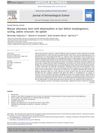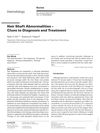TLDR Hair problems can be caused by genetics or the environment, and treatment should focus on the cause and reducing hair damage.
Hair shaft abnormalities, which can be congenital or acquired, manifest as changes in the hair's color, density, length, and structure, often leading to brittle and unmanageable hair that appears dry and lacks luster. These conditions can be localized or generalized and may be due to genetic factors or external influences. Diagnosing hair shaft diseases involves optic and polarized light microscopy, along with a thorough patient history and physical examination that includes other skin appendages. Understanding hair biology and embryology is crucial for identifying the various syndromes associated with hair shaft abnormalities. Treatment should address the underlying cause and minimize hair damage from external factors, with a recommendation for shorter hairstyles to ease management for affected individuals.
35 citations
,
September 2003 in “Archives of dermatology” Tiger tail bands in hair are caused by wavy hair fibers with melanin, unlike straight fibers in normal hair.
 34 citations
,
August 2003 in “Clinical and Experimental Dermatology”
34 citations
,
August 2003 in “Clinical and Experimental Dermatology” Pregnant women's hair gets thicker.
 40 citations
,
February 2002 in “International Journal of Dermatology”
40 citations
,
February 2002 in “International Journal of Dermatology” Permanent hair dye damages hair but it mostly recovers after 8 weeks; using certain hair care products can help repair it.
11 citations
,
January 1997 in “Journal of Dermatological Science” A new protein linked to hair strength was identified, aiding in understanding brittle hair conditions.
228 citations
,
January 1997 in “Birkhäuser Basel eBooks” Keratin proteins and their genes are crucial for hair growth and structure.
20 citations
,
January 1997 in “Dermatology” The patient with EEC syndrome had scarring alopecia due to deep folliculitis, possibly linked to abnormal hair structure.
30 citations
,
December 1996 in “Journal of Investigative Dermatology”
 52 citations
,
October 2012 in “Journal of Dermatological Science”
52 citations
,
October 2012 in “Journal of Dermatological Science” The document concludes that mouse models are crucial for studying hair biology and that all mutant mice may have hair growth abnormalities that require detailed analysis to identify.
 44 citations
,
January 2005 in “Dermatology”
44 citations
,
January 2005 in “Dermatology” Hair problems can be caused by genetics or the environment, and treatment should focus on the cause and reducing hair damage.
 12 citations
,
November 1987 in “Pediatric dermatology”
12 citations
,
November 1987 in “Pediatric dermatology” Four children had unmanageable pale blond hair due to uncombable-hair syndrome.





